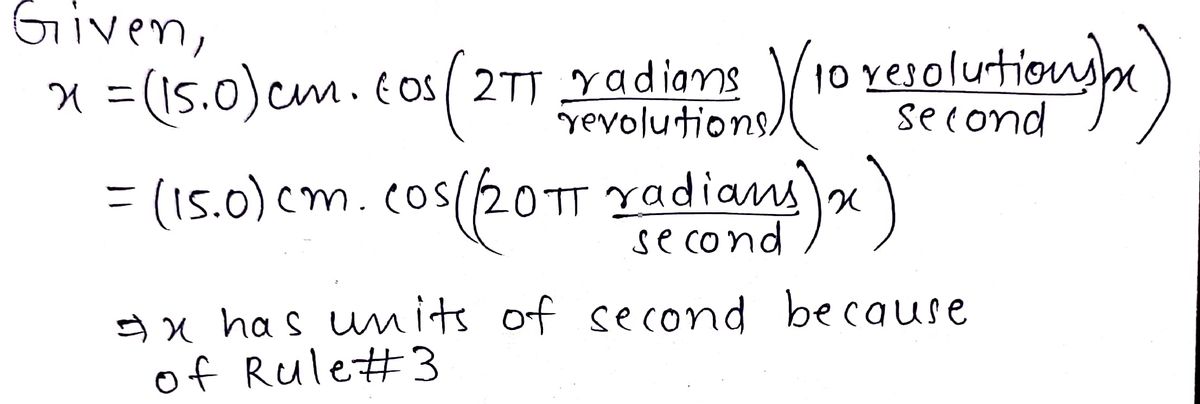z = (15.0 cm) - cos because of Rule # {(2π radians revolution T = To e(-x/(5 ms)) (10 revolutions second x has units of x has units of because of Rule #
z = (15.0 cm) - cos because of Rule # {(2π radians revolution T = To e(-x/(5 ms)) (10 revolutions second x has units of x has units of because of Rule #
Advanced Engineering Mathematics
10th Edition
ISBN:9780470458365
Author:Erwin Kreyszig
Publisher:Erwin Kreyszig
Chapter2: Second-order Linear Odes
Section: Chapter Questions
Problem 1RQ
Related questions
Question

Transcribed Image Text:The image contains the following mathematical expressions and notes:
1. \( z = (15.0 \, \text{cm}) \cdot \cos \left( \left( \frac{2\pi \, \text{radians}}{\text{revolution}} \right) \left( \frac{10 \, \text{revolutions}}{\text{second}} \right) x \right) \)
- The statement "x has units of ________" indicates a place to specify the units of \( x \).
- "because of Rule # ____" suggests there is a specific rule determining the units.
2. \( T = T_0 \cdot e^{-x / (5 \, \text{ms})} \)
- The statement "x has units of ________ because of Rule # ____" is for specifying the units of \( x \) using the rule mentioned.
No graphs or diagrams are present in the image.
![**Determine the Units of the Variable x**
In each of the following equations, specify which rule you used to determine the units of \( x \). Do not solve for the numeric value of \( x \). Show your work beneath the question, or on a separate sheet of paper.
**Example:**
\[ 315 \text{ feet} = \frac{1}{2} \left(32 \frac{\text{feet}}{\text{s}^2}\right)x^2 \]
**Result:**
\( x \) has units of \(\_\_\_\_\_\_\underline{\text{seconds}}\_\_\_\_\_\_\ \) because of Rule # \(\_\_\_\_\_\_\underline{1}\_\_\_\_\_\_\ \).
**Rules:**
- **Rule #1:** Both sides of the equal sign must have the same units.
- **Rule #2:** Values that are added or subtracted must have the same units.
- **Rule #3:** Argument of a trigonometric function must be an angle.
- **Rule #4:** Argument of an inverse trigonometric function must have no units.
- **Rule #5:** Exponents must have no units.
**Explanation:**
In the example, the units on both sides of the equation must match. Here, the equation is expressed as:
\[ 315 \text{ feet} = \frac{1}{2} \left(32 \frac{\text{feet}}{\text{s}^2}\right) x^2 \]
To determine the units of \( x \), consider that the unit equation simplifies to:
\[ \text{feet} = \text{feet} \cdot \text{s}^{-2} \cdot x^2 \]
Solving for \( x \), it is found that:
\[ x^2 = \text{s}^2 \]
Thus, \( x \) has units of seconds. This determination relies on **Rule #1** which states that both sides of the equation must have the same units, leading to the conclusion that \( x \) must have units such that when multiplied appropriately, it balances the units on both sides.](/v2/_next/image?url=https%3A%2F%2Fcontent.bartleby.com%2Fqna-images%2Fquestion%2F25b167f9-3118-479d-a9fb-f8c446c41f1a%2Fc88013e3-cb5b-4acb-a7ab-b21f5101ac0f%2Fgxwc1rn_processed.jpeg&w=3840&q=75)
Transcribed Image Text:**Determine the Units of the Variable x**
In each of the following equations, specify which rule you used to determine the units of \( x \). Do not solve for the numeric value of \( x \). Show your work beneath the question, or on a separate sheet of paper.
**Example:**
\[ 315 \text{ feet} = \frac{1}{2} \left(32 \frac{\text{feet}}{\text{s}^2}\right)x^2 \]
**Result:**
\( x \) has units of \(\_\_\_\_\_\_\underline{\text{seconds}}\_\_\_\_\_\_\ \) because of Rule # \(\_\_\_\_\_\_\underline{1}\_\_\_\_\_\_\ \).
**Rules:**
- **Rule #1:** Both sides of the equal sign must have the same units.
- **Rule #2:** Values that are added or subtracted must have the same units.
- **Rule #3:** Argument of a trigonometric function must be an angle.
- **Rule #4:** Argument of an inverse trigonometric function must have no units.
- **Rule #5:** Exponents must have no units.
**Explanation:**
In the example, the units on both sides of the equation must match. Here, the equation is expressed as:
\[ 315 \text{ feet} = \frac{1}{2} \left(32 \frac{\text{feet}}{\text{s}^2}\right) x^2 \]
To determine the units of \( x \), consider that the unit equation simplifies to:
\[ \text{feet} = \text{feet} \cdot \text{s}^{-2} \cdot x^2 \]
Solving for \( x \), it is found that:
\[ x^2 = \text{s}^2 \]
Thus, \( x \) has units of seconds. This determination relies on **Rule #1** which states that both sides of the equation must have the same units, leading to the conclusion that \( x \) must have units such that when multiplied appropriately, it balances the units on both sides.
Expert Solution
Step 1

Step by step
Solved in 2 steps with 2 images

Recommended textbooks for you

Advanced Engineering Mathematics
Advanced Math
ISBN:
9780470458365
Author:
Erwin Kreyszig
Publisher:
Wiley, John & Sons, Incorporated

Numerical Methods for Engineers
Advanced Math
ISBN:
9780073397924
Author:
Steven C. Chapra Dr., Raymond P. Canale
Publisher:
McGraw-Hill Education

Introductory Mathematics for Engineering Applicat…
Advanced Math
ISBN:
9781118141809
Author:
Nathan Klingbeil
Publisher:
WILEY

Advanced Engineering Mathematics
Advanced Math
ISBN:
9780470458365
Author:
Erwin Kreyszig
Publisher:
Wiley, John & Sons, Incorporated

Numerical Methods for Engineers
Advanced Math
ISBN:
9780073397924
Author:
Steven C. Chapra Dr., Raymond P. Canale
Publisher:
McGraw-Hill Education

Introductory Mathematics for Engineering Applicat…
Advanced Math
ISBN:
9781118141809
Author:
Nathan Klingbeil
Publisher:
WILEY

Mathematics For Machine Technology
Advanced Math
ISBN:
9781337798310
Author:
Peterson, John.
Publisher:
Cengage Learning,

